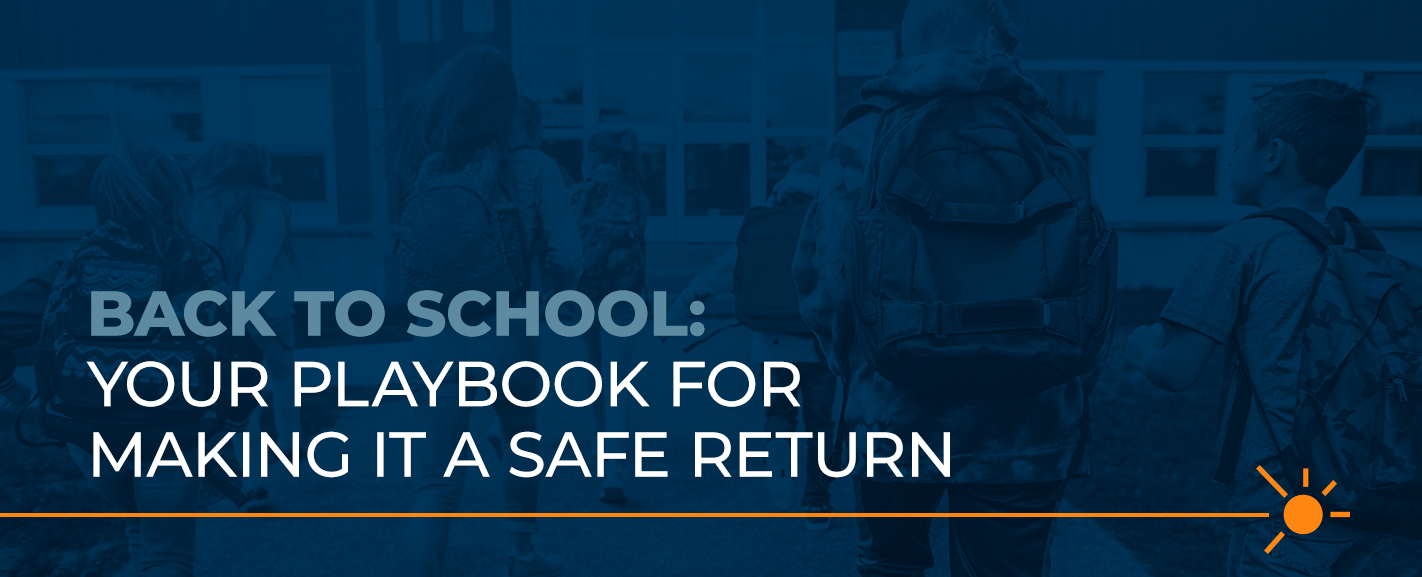
With 56.4 million K-12 students across the country, preparing for K-12 school reopening is crucial for reducing the spread of COVID-19 and protecting student and staff health on a national level. Now more than ever with the COVID-19 global pandemic, students’ needs are changing, and education trends continue to evolve at a rapid pace. Given the critical nature of the current environment, do you have a playbook for making it a safe return for them?
To help schools prepare for a return to school in the middle of a pandemic, this piece will explore key areas for consideration when developing a plan to protect your schools. We’re here to help you establish effective school reopening safety precautions as you navigate the uncharted territory of returning to school during COVID-19.
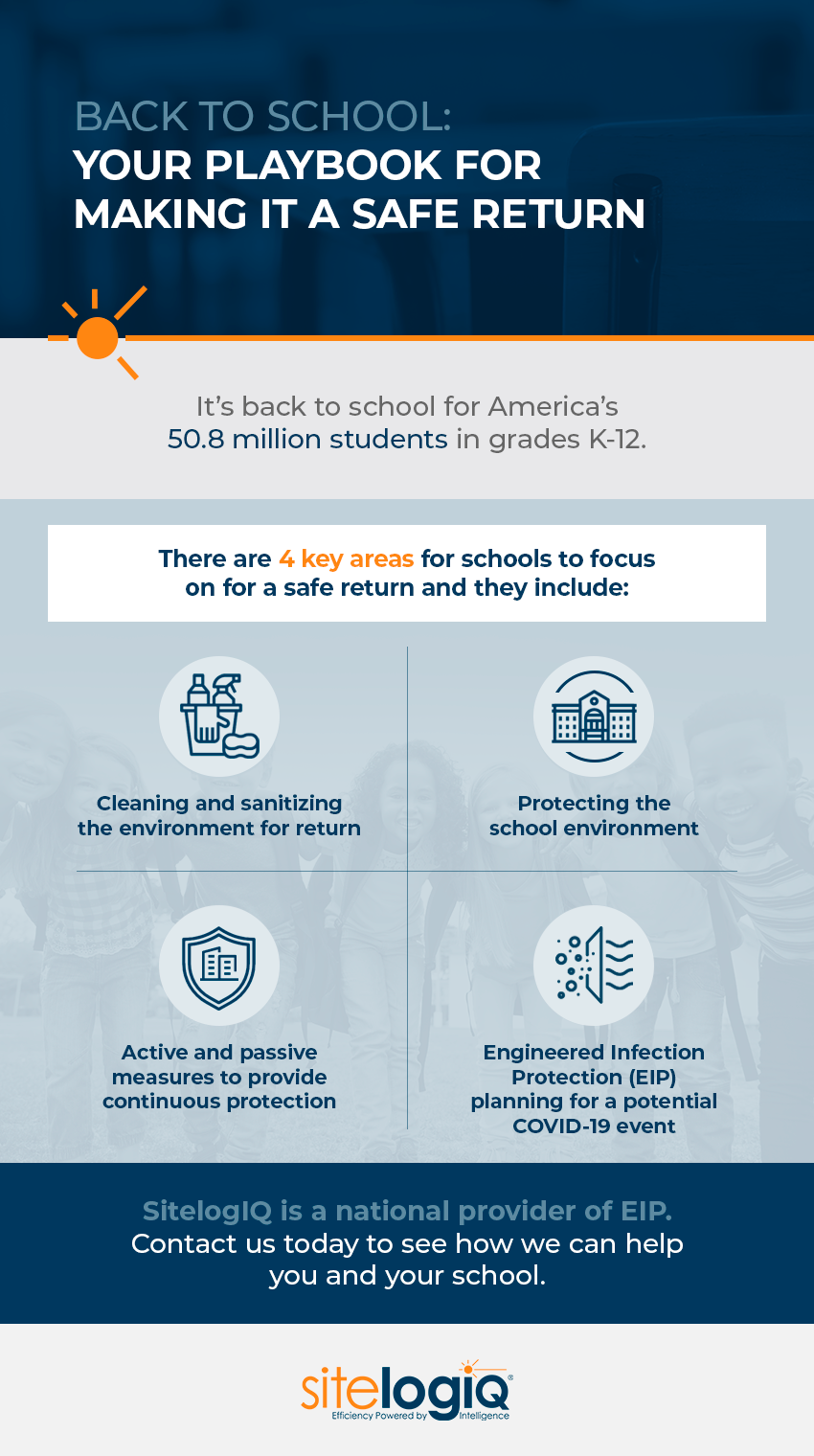
5 Key Areas of Consideration for Back to School Safety
There are five main K-12 school reopening safety considerations to take into account this year:
- Planning ahead and making preparations
- Cleaning and sanitizing
- Protecting the school environment
- Active and passive measures to provide continuous protection
- Engineered infection protection planning for a potential COVID-19 event
Although these facets of school safety have always been imperative, the COVID-19 pandemic has made them even more critical. To help facilitate a safe return to school this year, each key area will be expanded upon and explained in detail below:
1. Planning Ahead and Making Preparations
You will need to have a clear approach to starting the year that includes an in-depth look at what changes or upgrades need to be made to your facility to best serve students and teachers while protecting their health. Following a well-thought-out plan can equip your school building to provide a safe, supportive, and comfortable environment during these unique times and in the years to come.
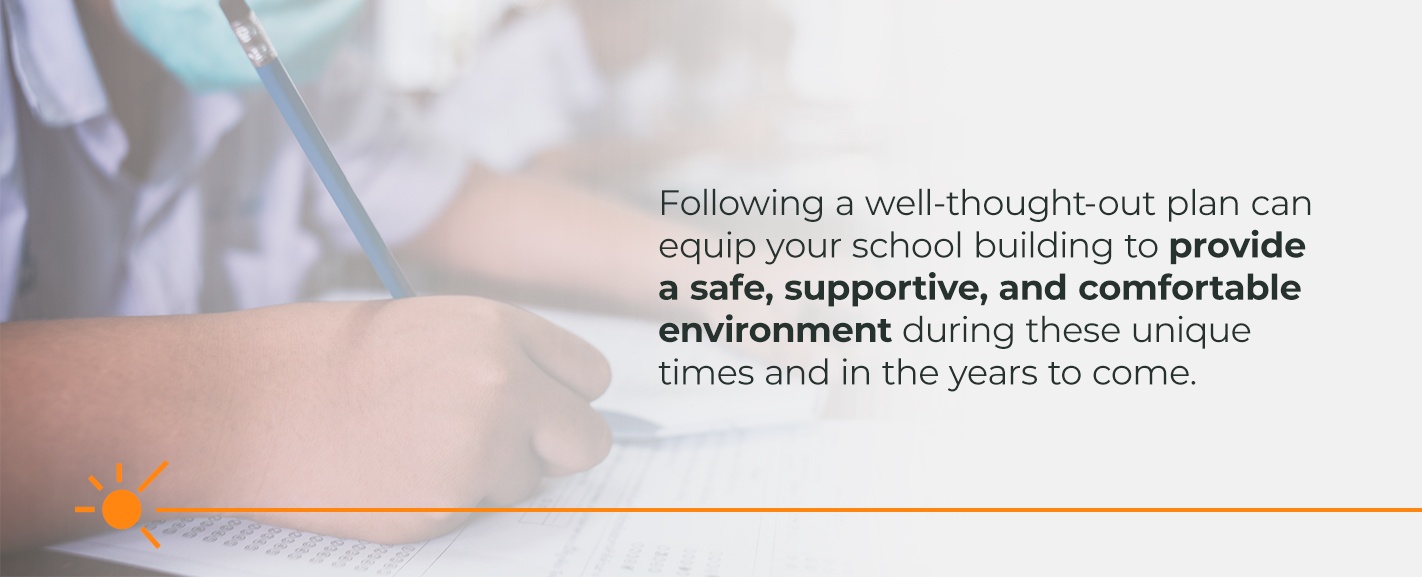
During your planning stage, these are five steps you need to take:
- Analyze the capabilities of your existing facility.
- Perform an operational cost analysis of your facility to find out whether renovating or repairing any infrastructure would be cost-effective.
- Coordinate appropriate funding options to cut down on costs incurred by your school and community as much as possible.
- Assess the adequacy of your facility to make sure it would be compatible with modern resources and technologies.
- Prepare your existing facility for rehabilitation and renovations.
Assessing your school’s financial situation and planning out your budget ahead of time can help your school take advantage of the federal, state, and local funds available for disaster relief. Discussing disaster relief funding will help address immediate concerns — such as making sure you’re eligible for grants like FEMA — and prepare your school for the post-pandemic environment by ensuring you receive future financial assistance from funds like the C.A.R.E.S. Act.
After organizing your school’s finances, you can start preparing your building for the upcoming year by risk assessment planning. Coming up with a plan that takes all possible future conditions into account is necessary for creating a safe, healthy, and productive environment. Your plan should focus on implementing immediate solutions, such as installing protective measures and engineered infection protection services, along with addressing long-term concerns for your facility’s maintenance and master planning.
Once you have reviewed how you will finance your school building’s extra needs this year and planned for the potential risks, you will be able to begin readying the building’s interior for occupants.
2. Cleaning and Sanitizing
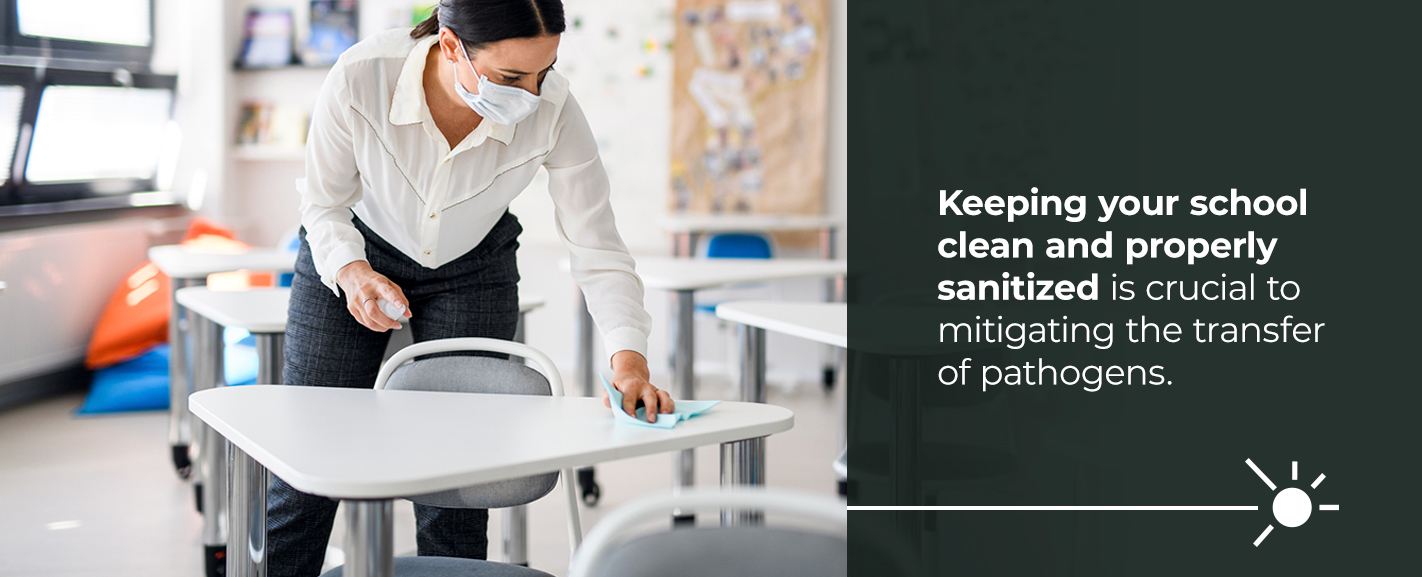
Keeping your school clean and properly sanitized is crucial to mitigating the transfer of pathogens. Using a multi-tiered approach to pathogen mitigation solutions is an effective method of employing precautionary cleaning measures and taking care of suspected or confirmed contamination within your facility. These sanitation measures can also be used in your building environment permanently to help keep it clean and safe.
The following are the three most effective short-term pathogen mitigation solutions:
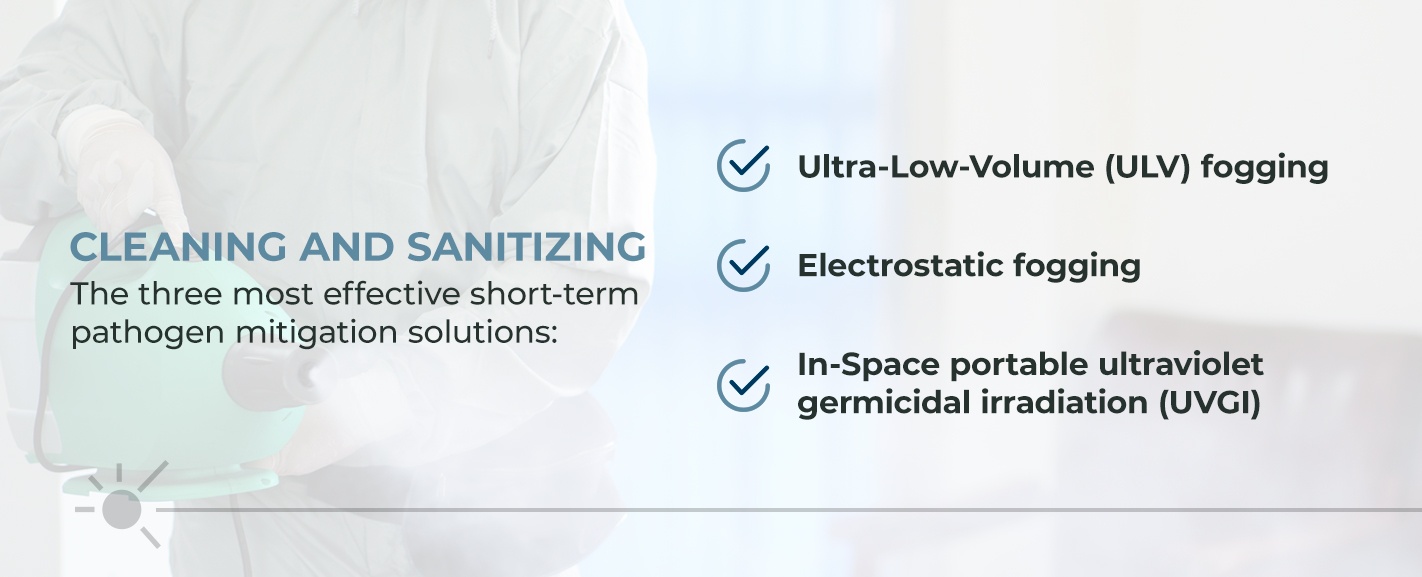
- Ultra-Low-Volume (ULV) fogging: Cold fogging machines like a ULV fogger use large volumes of air at low pressure to transform liquid solutions into droplets that are dispersed into the air like fog to treat contaminants. Specifically, a ULV fogging treatment covers large areas during a 10-second dwell time while leaving little to no residue on the surfaces it goes over. Research has found that using fog to deliver solutions as a small aerosol mist is an effective method for disinfecting an area and sanitizing it against the COVID-19 virus.
- Electrostatic fogging: Electrostatic technology follows a one-step disinfectant process that puts a positive charge on the liquid solution before it enters the nozzle, allowing the maximum amount of solution to be charged, atomized, and delivered to surfaces. Electrostatic fogging is an efficient way to achieve thorough and consistent coverage of all surface areas and sanitize them against the COVID-19 virus along with other pathogens in mere seconds. This type of fogging machine is also safe to use around electronics and requires no rinsing or wiping after application.
- In-Space portable ultraviolet germicidal irradiation (UVGI): This approach to decontaminating the indoor air environment by using UV light to kill or inactivate contagions at their source is a proven method for removing infectious microorganisms from facilities. The Centers for Disease Control and Prevention (CDC) has suggested using UVGI as a technique for inactivating potential airborne viruses, including the SARS-CoV-2 virus that causes COVID-19. This process is effective in common occupied spaces because broad-spectrum UV light destroys the viruses’ DNA bond.
No single approach is the universal answer for all facilities, so it’s important to take your existing systems into consideration before choosing a cleaning and sanitizing method. Your facility’s environment may benefit most from a combination of these cleaning techniques, so be sure to consult with a professional before making any final decisions.
3. Protecting the School Environment
ULV fogging, electrostatic fogging, and UVGI are appropriate short-term solutions to sanitize your facility and get it clean for students and teachers. But you also need a plan to protect the school environment in the long term. Taking measures to preserve the properly cleaned state your school is now in can ensure a safer, healthier environment for everyone.
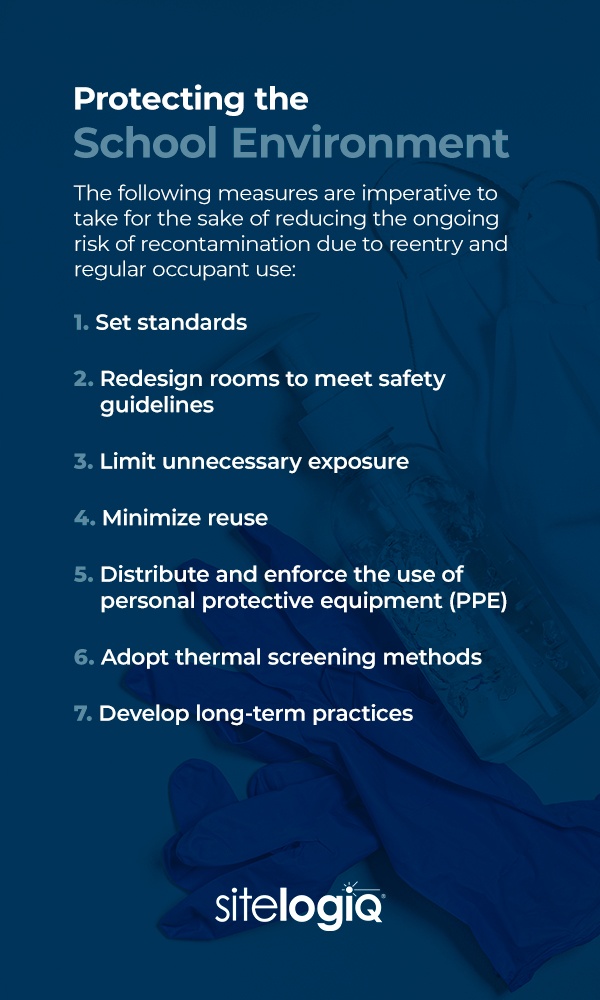
The following measures should be considered to reduce the ongoing risk of recontamination due to reentry and regular occupant use:
- Set standards: Posting signage that promotes proper health practices, such as wearing a mask, keeping a safe physical distance, and washing hands frequently helps keep all school building occupants informed of how to stay safe and healthy.
- Redesign rooms to meet safety guidelines: Adjust the layout and spacing of classroom and school nurse office furniture to allow for proper physical distancing.
- Limit unnecessary exposure: Protect students and faculty in places where close contact is inevitable by putting up physical barriers, such as sneeze guards, in areas like vestibules, main offices, spaces for large groups, the school nurse’s office, and more.
- Minimize reuse: Whenever possible, prevent the sharing of items like utensils, tablets, or headphones. For situations in which common usage cannot be avoided, make sure the shared item is properly wiped down and disinfected in between uses to mitigate the spread of pathogens.
- Distribute and enforce the use of personal protective equipment (PPE): Routinely using PPE supplies, such as masks and hand sanitizer, and making them accessible for all students and teachers is an advised precaution for preventing the spread of infection.
- Adopt thermal screening methods: The best way to keep those within your school safe is by reducing the risk of exposure to be as low as possible. One measure to help achieve this is using thermal screening solutions at the entrance points or high traffic areas of the building. Using thermal temperature detection devices gives you a touchless option for rapidly screening those who enter the facility and identifying anyone who may unknowingly bring the virus into the school.
- Develop long-term practices: Use ongoing solutions focused on new and enhanced sanitary procedures to keep your facility’s cleaning protocol up to standard and its occupants protected.
4. Active and Passive Measures to Provide Continuous Protection
Your school building will need to adopt ongoing active and passive protection measures to guard against the COVID-19 pandemic. Longer-term solutions will involve monitoring indoor air quality (IAQ) to control airborne contamination and taking extra surface contamination steps. By taking a holistic approach to cleansing your school’s IAQ and surface areas, you can cultivate an environment that is safe, healthy, and protected from potential complications.
Because about 80% of human infections are spread through direct and indirect contact, maintaining the quality of your indoor air is an extremely important component of keeping your building’s occupants healthy. Although most of us think of direct contact transmission as shaking hands or hugging, direct contact also includes activities like talking or coughing, which can spread the virus to anyone within a few feet of the source through aerosols.
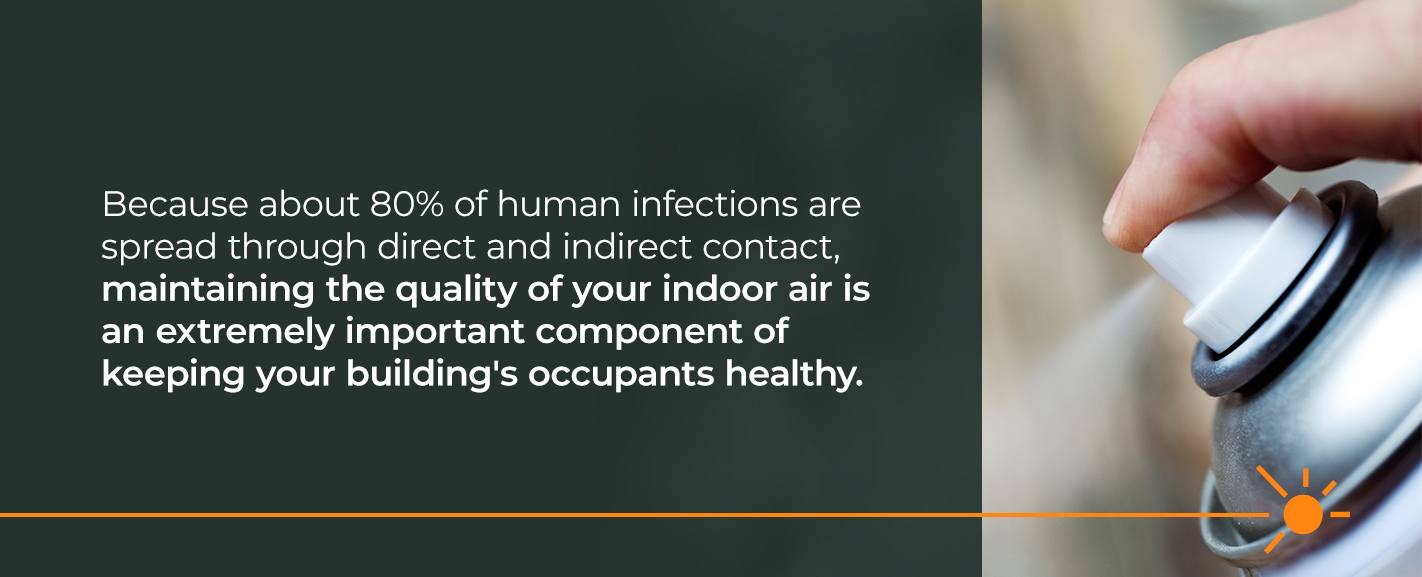
The COVID-19 virus is primarily spread by these aerosolized droplets that can travel up to 6 feet and stay alive in the air for hours. Once airborne, these infectious droplets can be transferred through heating, ventilating, and air conditioning (HVAC) systems if proper precautions aren’t put in place. Although filters alone aren’t enough to prevent a virus from being distributed throughout a building by its HVAC system, there are some HVAC modifications that can easily improve your school’s IAQ.
Researchers have found that effective ventilation, disinfection incorporated with air filtration, and the avoidance of air recirculation and overcrowding, can be used to suppress the spread of COVID-19 through aerosols and airborne contamination. One of the most effective ways to filter and purify your indoor air is through bipolar ionization, which produces charged ions that target the contaminants in the air you breathe with disinfection. By latching on to oppositely charged ions, bipolar ionization can make aerosols like viruses, bacteria, and dust particles heavier and more easily trapped by HVAC system filters.
Follow this list of airborne contamination control measures to enhance your school’s IAQ:
- Place ionization filtration units in the HVAC systems: Receive the benefits of bipolar ionization by upgrading the filtration units in your building’s HVAC systems.
- Use UVGI in the building’s HVAC units and upper air zones: UVGI can be used throughout the school year to purify the air within the building by killing potentially infectious bacteria and viruses.
- Retro-commission the HVAC systems implementation of UV-C lighting: Take advantage of UV-C lighting, the shortest and most powerful UV wavelength, by using it to safely disinfect the air inside your building after school hours to eliminate the risk of radiation exposure.
- Install variable-frequency drives (VFD): Using VFD technology will allow you to closely monitor and control the HVAC systems’ fans or pump motors.
- Practice proper humidification: Keeping your facility’s humidity levels between 30% and 50% can help prevent the symptoms caused by dry air and respiratory problems from high humidity.
- Manage the facility’s airflow: Bettering the building’s overall airflow can prevent the air from becoming stagnant and stale.
- Increase outside air ventilation: Taking in more air from outside boosts IAQ by providing a natural source of airflow.
- Make improvements to the existing filtration system: Depending on how up-to-date your facility’s filtration system is, a few modifications may be enough to meet proper safety measures.
Along with airborne contamination control measures, you will need to take some extra surface contamination control measures to protect students and teachers from pathogens. Viruses like COVID-19, SARS, and MERS can live for up to 72 hours on stainless steel and 96 hours on glass, so it’s imperative you regularly disinfect and sanitize the surfaces within your school building.
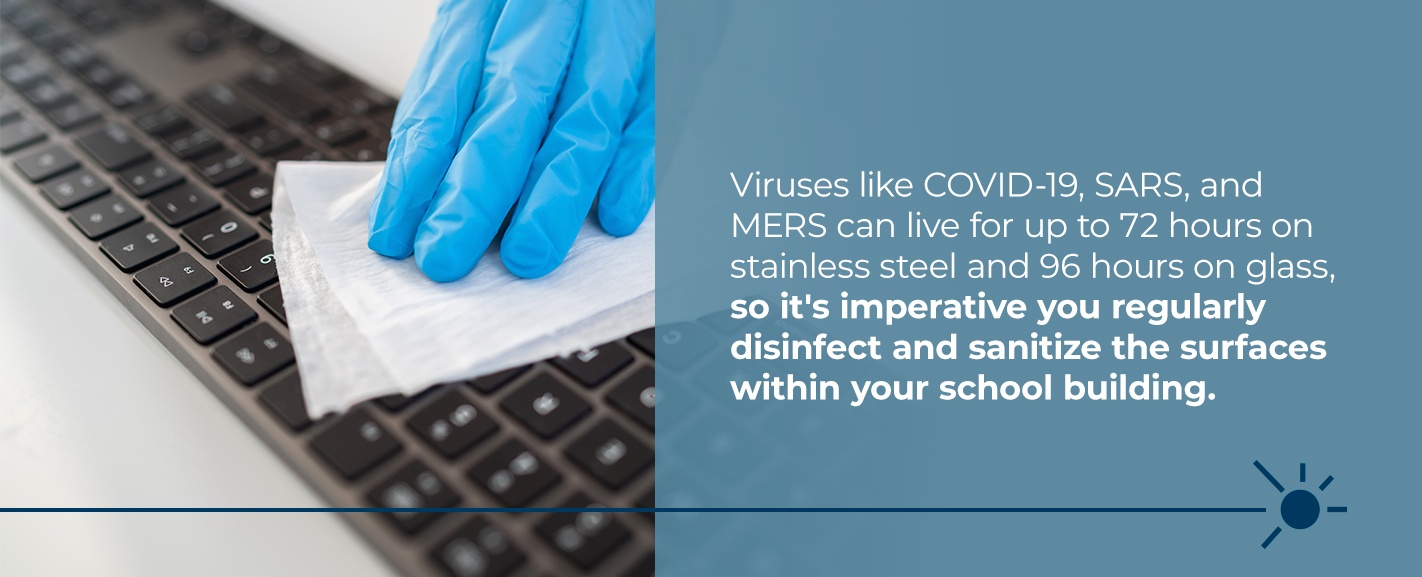
To kill or slow the spread of microorganisms on surfaces, you can use antimicrobial cleaning products. Whenever an antimicrobial product claims to control, kill, mitigate, repel, or reduce a pest, it is considered a pesticide and regulated by the U.S. Environmental Protection Agency (EPA). Although these products can be highly effective surface disinfectants, they should never be used directly on the human body.
These are the three types of antimicrobial pesticides:
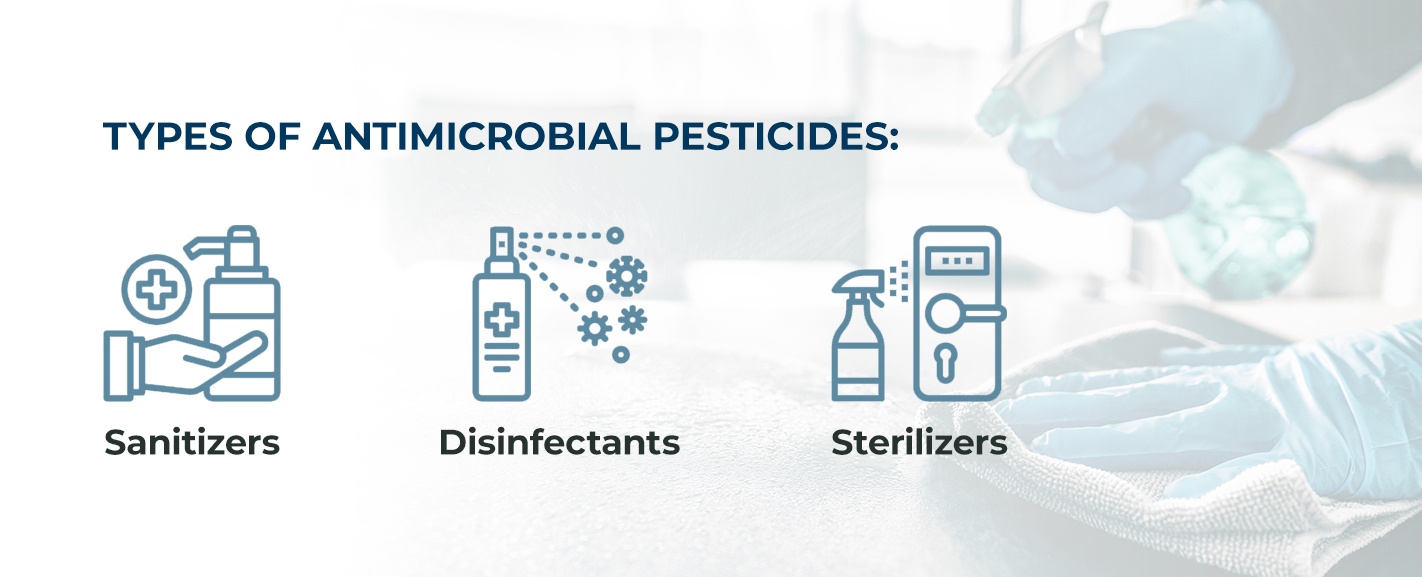
- Sanitizers: As the weakest public-health antimicrobials, sanitizers are suitable for use on food-contact surface areas, such as countertops and cutting boards, to reduce bacteria.
- Disinfectants: Slightly stronger than sanitizers, disinfectants are able to kill bacteria and fungi, prevent their growth, and even target certain viruses. Disinfectants are most commonly used as the preferred public-health antimicrobial for surfaces within medical and residential settings.
- Sterilizers: Sterilizers are the strongest category of antimicrobial products, killing bacteria, fungi, algae, and difficult-to-kill spores. The use of sterilizers is typically reserved for research or medical settings in which microbes need to be prevented as much as possible. Many sterilizers are restricted-use pesticides and require special training and certification.
Regardless of which type of antimicrobial product you choose, carefully read its label before using it to ensure it is applied correctly. Also, make sure any antimicrobial pesticides you use within your school are registered with the EPA, which means their claims of efficiency against pathogens have been reviewed, found valid, and approved.
Antimicrobial products that are safe for contact with skin are regulated by the U.S. Food and Drug Administration (FDA) as drugs or antiseptics. These types of antimicrobial products include washes, soaps, rubs, hand sanitizers, and antiseptic wipes. The FDA evaluates these antimicrobials based on their safety and efficacy for preventing illness.
Within a school there are naturally high-traffic surface areas, resulting in high-touch surfaces. Putting both short-term and long-term precautions in place can help minimize exposure to viruses and bacteria. Of course, the best way to mitigate the spread of pathogens is to completely avoid contact with these high-touch surfaces by using any existing touchless technology your building has. But that is not always possible.
For instances when contact with a high-touch surface is inevitable, use these three tips to lessen the risk of pathogen spread:
- Put antimicrobial surface coatings on all the doors, doorknobs, push bars, railings, faucets, bathroom fixtures, drinking fountains, and playground equipment.
- Try to use materials that shorten the life of the virus, such as copper, on high-touch areas.
- Use touchless control automation whenever possible.
There is no need to renovate all the school building’s bathrooms to reap the contamination-controlling benefits of touchless control automation — although it would be worthwhile if financially possible. Simply switching to infrared thermometers, offering touchless payment options in the lunchroom, or installing touchless automatic hand sanitizer dispensers in certain rooms can help reduce the risk of pathogen spread. To comply with CDC guidelines and effectively control the spread of the COVID-19 virus, be sure any alcohol-based hand sanitizer you use consists of at least 60% alcohol.
5. Engineered Infection Protection (EIP) Planning
Maintaining a safe and healthy school building environment includes preparedness planning using EIP solutions to properly handle suspected or confirmed COVID-19 cases. No matter how well you clean, disinfect, and sanitize your school’s facility, you cannot completely eliminate the possibility of a positive COVID-19 test from one of its occupants. Mapping out a specific procedure for navigating positive cases is the key to securing the health and safety of your facility now and for the future.
According to the CDC, a single positive COVID-19 test is not a reason for a school to shut down entirely as long as plans have been put in place to minimize the spread. The CDC suggests cohorting, or forming small groups of students and teachers that stay together throughout the school day, as an effective strategy for reducing exposure and mitigating the spread of pathogens. By keeping students and staff in organized cohorts, the school can exercise targeted isolation procedures in the event of a positive COVID-19 case instead of taking school-wide measures.
While cohorting can help keep a COVID-19 case contained and reduce transmission of the virus, schools still need further EIP planning in place to properly address a potential outbreak. The EIP plan should provide detailed steps to take for contact tracing, testing, and quarantining once a positive case has appeared within a cohort.
When forming your EIP plan, identify the highest-risk areas according to your previous risk assessment planning, then use a selection matrix to prioritize areas based on asset condition, funding opportunities, financial contributions, and overall project cost. Once you have concluded which areas of your building can be used for confining positive cases, you will be able to create an EIP plan that simultaneously protects the health and safety of your school while following a system best-suited for keeping your building open.
Fully addressing the complexity of current health and safety guidelines requires that your EIP plan includes these five essential precautionary measures:
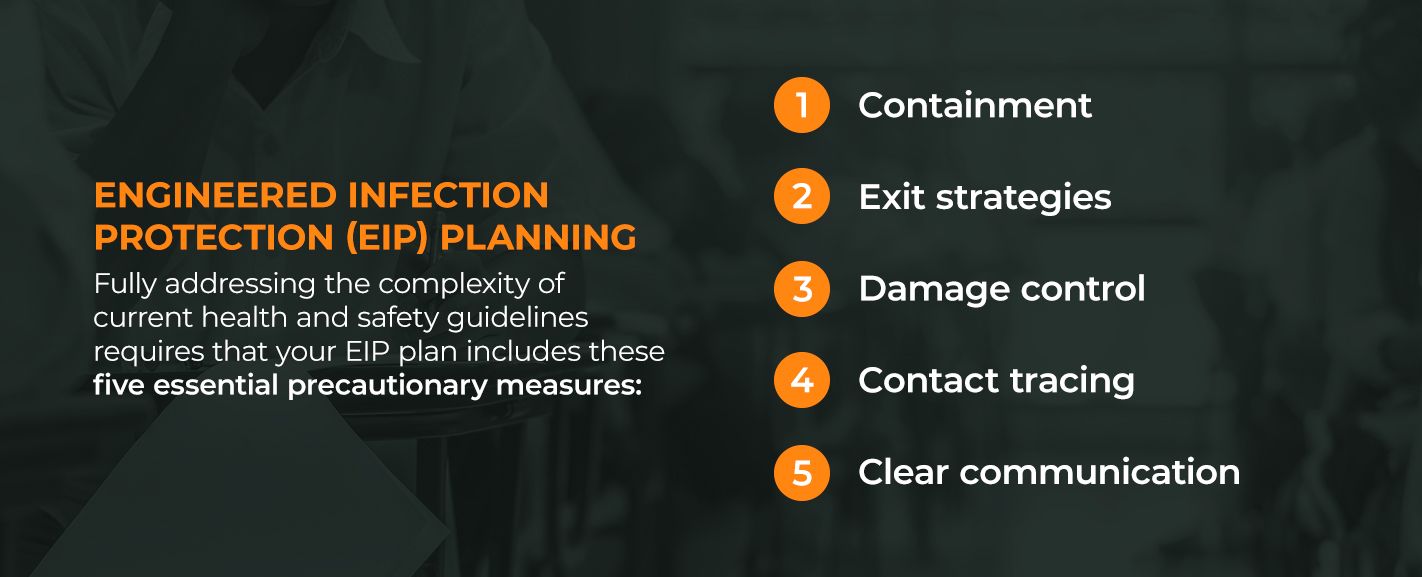
- Containment: Quickly and effectively containing a positive COVID-19 case is the best way to prevent a full-blown outbreak. Your EIP plan will need to include designated isolation areas for containment in the event of a positive COVID-19 test.
- Exit strategies: Another way to control the spread of potential positive cases is to establish viable exit strategies for those who have tested positive that will limit their exposure to others while safely removing them and the threat of the virus from the facility.
- Damage control: Thorough pathogen mitigation and cleaning protocols to disinfect areas that may have come in contact with the virus will serve both the short-term and long-term well-being of the school’s environment.
- Contact tracing: Putting a contact tracing program in place can help manage school occupants’ exposure to positive cases and neutralize potential outbreaks.
- Clear communication: An in-depth communication plan for faculty members and parents that accurately conveys the important actions you’ve taken to create a safe learning environment is important for the staff and students returning to this school year
Contact SitelogIQ to Protect Your Facility and Get Back to School Safely
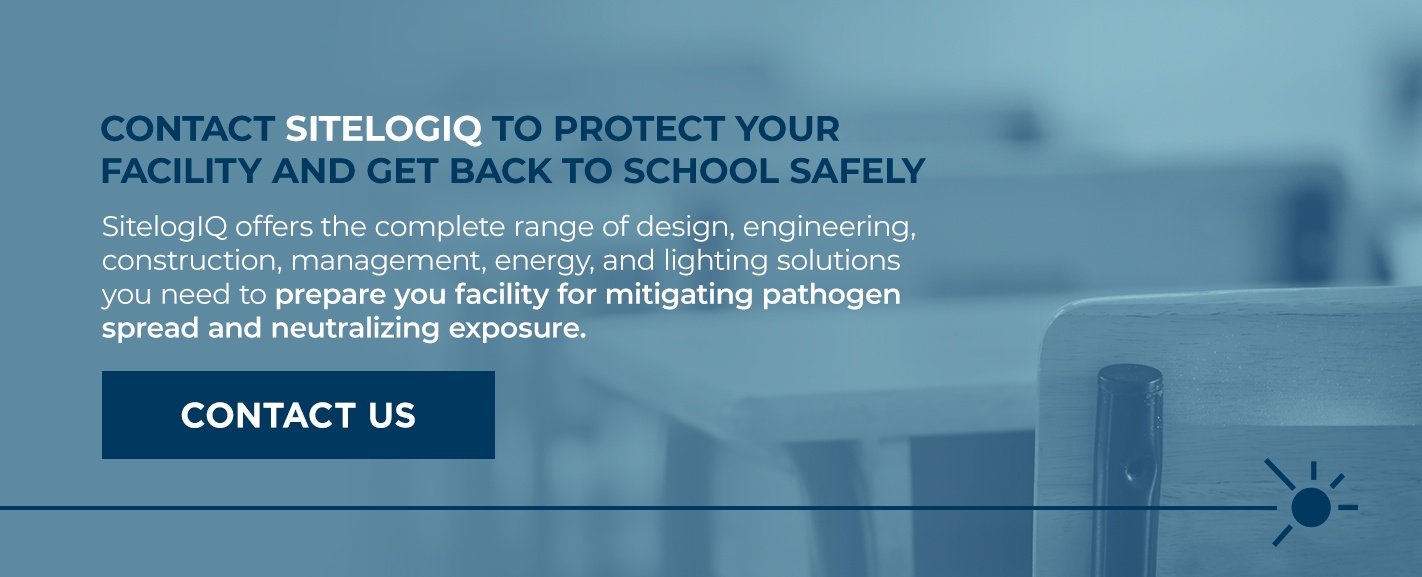
As a national provider of EIP, energy efficiency, and master planning solutions, SitelogIQ has the necessary tools and experience to help you keep your school environment safe and healthy throughout the year. SitelogIQ offers the complete range of design, engineering, construction, management, energy, and lighting solutions you need to prepare you facility for mitigating pathogen spread and neutralizing exposure.
To learn more about how SitelogIQ can prepare your school building to safely accommodate students and staff and maintain a healthy environment, contact us online or call 888-819-0041 today.


